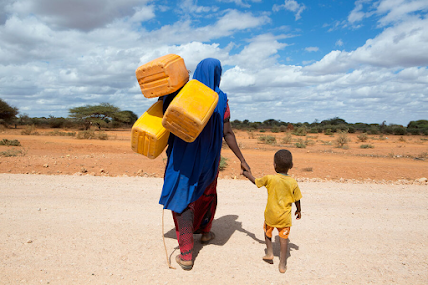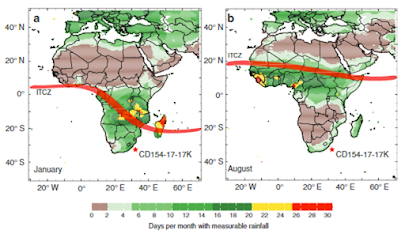Introduction To Water And Food In Africa
Water scarcity, famine and hunger crises are dominant
topics that circulate the media when talking about the continent of Africa. Figure 1 shows how dry
barren land, children starving and women walking miles to access water is a
popular narrative used to catch viewers’ or readers’ sympathy and attention.
This is where my interests in water and food in Africa stem from. How true is
this image of Africa that Western media presents it to be? What are the
complexities of the relationship between water and food in Africa and how will
they be impacted under a changing climate? This blog aims to understand more
about the availability and access to water across countries in Africa and its
complex relationship with food production.
Safe, clean drinking water is a basic human right and
necessity. Undoubtedly, its relationship with agriculture and food production
is highly significant for human life. In 2015, the United Nations (UN) set up 17 Sustainable Development Goals (SDGs) to address the social, economic and
environmental problems that we face today and eradicate them by 2030. SDG 6 aims
to ‘ensure availability and sustainable management of water and sanitation for
all’ whilst SDG 2 focuses on ending hunger and promoting sustainable
agriculture. However, whilst facing the threats of climate change, an
intensifying hydrological cycle and a growing population, how likely are countries
in Africa going to meet these goals?
Water scarcity is defined as an imbalance between water
supply and demand, where demand exceeds availability of freshwater (Taylor, 2011). The water stress index (WSI) defines a region to be water scarce if less than 1000m3
of water is available per person each year (Falkenmark, 1989), but this does not take into account political, socio-economic and cultural factors that also influence access to
freshwater (Damkjaer and Taylor, 2017). Currently, 1 in 3 people in Africa are known to face water scarcity
and it’s likely that this will only worsen.
The Intertropical Convergence Zone (ICTZ) drives seasonal precipitation across sub-Saharan Africa leading to many people relying on rain-fed agriculture as their main source of food production (Ziegler et al., 2013). However, this variability in precipitation will intensify leaving many areas vulnerable to drought conditions and unable to support agriculture (Ahmadalipour et al., 2019). Perhaps farmers will have to look at other sources of water, such as groundwater for irrigated agriculture, to establish food security now and under a growing population and changing climate (MacDonald et al., 2012). This will be explored more in the next post.
Reflection on writing about Africa:
Africa is one the most diverse continents on Earth, home to
54 countries, 1.4 billion people and approximately one-third of the world’s languages. Yet, it is often portrayed as a single entity within popular media, devoid
of its rich cultures, histories and ecosystems that shape it. Binyavanga Wainana criticises this and encourages us to be conscious of the way we talk
and write about Africa, to not romanticise the continent and its peoples or
treat it as ‘exotic’ or ‘wild’. Instead of discussing generalised stereotypes, these blog posts will aim to represent
ideas as accurate as possible, without broad brushing topics or taking part in
performative allyship. Hence, in these series of blog posts, I will constantly reflect
on the language, images and media I use to ensure I present an accurate reflection
of water and food in Africa!




This is a good introductory post showing a sound understanding of water issues in Africa, especially the link between water and food, and you have engaged with a selection of relevant literature with a good referencing. Hopefully the case studies of water and food issues in Africa will feature in subsequent posts
ReplyDelete